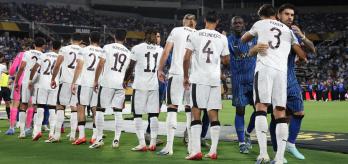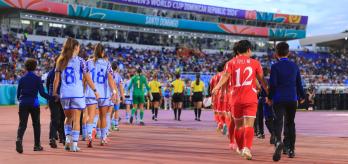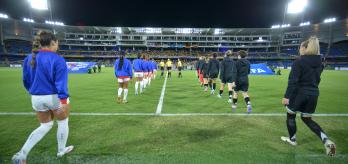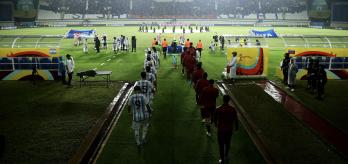Key take-aways
- Relatively older players are over-represented in most squads at the tournament, suggesting that the relative age effect is a significant factor in elite youth football.
-
More than 80% of the players appearing in Indonesia are attached to clubs whose senior sides play in the top divisions of their respective national leagues, showing the key role of professional clubs’ academies in developing young players.
-
However, the dominance of the professional clubs is not universal. The United States, Japan, South Korea and all the African sides at this U-17 World Cup prove that there are other ways of climbing the football pyramid.
Introduction
This article analyses the players taking part in the finals of the FIFA U-17 World Cup, which is taking place in Indonesia between 11 November and 2 December 2023. Of the 24 national teams that qualified for the finals, only the Indonesian hosts are taking part in the tournament for the first time. In contrast, the United States and Brazil are each making their eighteenth appearance since the first tournament in 1985.
This analysis focuses initially on the age of the players at the tournament, and specifically examines which calendar month they were born in. This data enables us to investigate the “relative age effect” within the under-17 age group. The term “relative age effect“ is used to refer to the way players who are at the older end of their respective age groups tend to be over-represented in competition because they have a built-in advantage over younger players in terms of physical maturity. Players were eligible to play in this tournament if they were born on or after 1 January 2006 and before 1 January 2009, and players born in the early months of the calendar year might be expected to benefit from the relative age effect.
Secondly, the article analyses which clubs employ the players appearing at the tournament. The study focuses in particular on the number of clubs represented within each squad, as well as on the proportion of those clubs whose first teams play in the top divisions of their national leagues.
The relative age effect
The most common way of analysing the relative age effect is to divide the year into four quarters. At this tournament, 85.1% of the players (429 of 504) were born in 2006. Of these, the proportion born in the first quarter of that year (January to March) is 44.1%, 19.1% higher than the 25% one would expect to see if the month of birth had no impact on selection.
The over-representation of players born between January and March also applies to players born in 2007 and 2008 (where 45.3% of players were born in the first quarter). Across all the players at the FIFA U-17 World Cup, the proportion born in the first quarter of the year is 44.2%, and the percentage of players born in the first half of the year is 70.2%.
These findings suggest that footballers born earlier in the year have an advantage over those born later. The relative age effect can be observed in relation to almost all of the teams that qualified for the tournament. The most extreme examples are Iran and Argentina: two thirds of their players were born in Quarter 1 and fully 85% were born in the first half of the calendar year (a figure matched by France).
Mali is the only team in which players born in the first quarter of the year are not over-represented; surprisingly, players born in last quarter of the year are actually over-represented in their squad. Two other African sides, Senegal and Burkina Faso, show a similar distribution. If these three exceptional cases were excluded from the statistics, the proportion of players born between October and December would be even lower (7.7% rather than 12.1%).
Where do these players play their football?
The 504 players taking part in the FIFA U-17 World Cup play for no fewer than 281 clubs or schools (school football at this level is confined to Japan and South Korea). In some African countries and in the United States, some bodies and organisations involved in training youth players operate exclusively at youth level, but remain affiliated to their national associations so as to benefit from the protections provided by national and international regulations on the training and transfer of players.
The number of clubs represented within each squad varies significantly, from a minimum of eight (for Ecuador and Uzbekistan) to a maximum of eighteen (for the United States). Within the Canadian squad, almost half the players selected (10 out of 21) play for the same club. At the other end of the scale, no club provides more than two members of the USA’s U-17 squad.
Overall, 80.2% of the players at the FIFA U-17 World Cup play for clubs whose senior teams compete in the top divisions of their respective national leagues. This figure shows the close correlation between the youth and senior levels of elite football. This proportion was highest for the associations within CONMEBOL (at 96.4%), while, for the reasons given above, the lowest figures were for CAF (67.9%) and the AFC (70.5%).
The list of teams with the most players at the 2023 FIFA U-17 World Cup is headed jointly by Senegal’s AS Génération Foot and Canadian club Toronto FC (each of which have 10 players at the tournament). Founded in 2000 as a youth academy, Génération Foot has gradually established itself in the senior ranks. This process culminated in their first senior Senegalese league title in 2017, and they have won two more domestic championships since. By contrast, Toronto FC was founded as a senior professional club in 2006 and has been participating in the MLS since 2007. It has invested significant resources in youth training, becoming a leader in this field across Canada.
Conclusion
This article shows that the relative age effect is a major presence in youth football. While awareness of this phenomenon is increasing, players born earlier in the year continue to be favoured over those born later. This reflects a context in which short-term results tend to be prioritised over potential longer-term achievements.
The relative age of players within individual age groups thus continues to have a profound effect on the landscape of elite football, and there is a clear preference for footballers who are ready to perform immediately at a high level to the detriment of athletes who are less precocious in terms of their physical and psychosocial development (this applies to all players, regardless of their month of birth). It can therefore be said that a player born late in the year who is not an early developer has little chance of being selected for their national youth team.
The analysis of the clubs where the players appearing at the 2023 FIFA U-17 World Cup are employed shows the close correlation between elite football at youth and senior level. More than four-fifths of the players play at clubs whose senior teams compete in the top divisions of their national league structure.
However, it should be noted that this proportion is well below average for countries affiliated to CAF and the OFC. In Africa, this result is linked to the important role played by organisations and clubs who are exclusively focused on developing young players. Examples include Mali’s Académie JMG, which is based in Bamako and develops players for senior club FC Guidars, and the Mohammed VI Academy in Morocco, which was created by royal decree and develops players for all Moroccan clubs. In Asia, on the other hand, the relatively low proportion of active U-17 players attached to top division clubs is explained by the importance of the school system in the development of elite footballers. This can be seen in many high school clubs in Japan (such as Kamigaku, Nissho Gakuen and Nihon) and South Korea (such as Boin, Jungkyung, Shinpyeong and Yeongdeungpo).



























